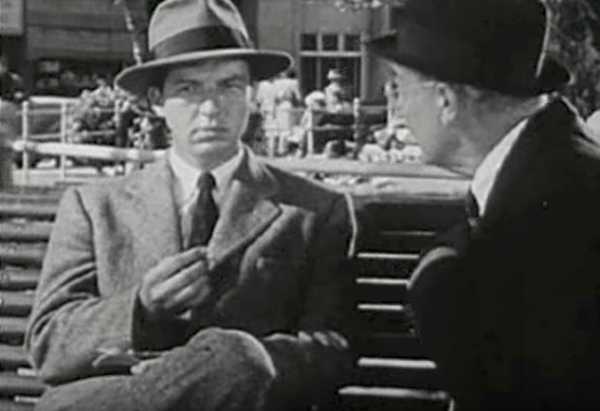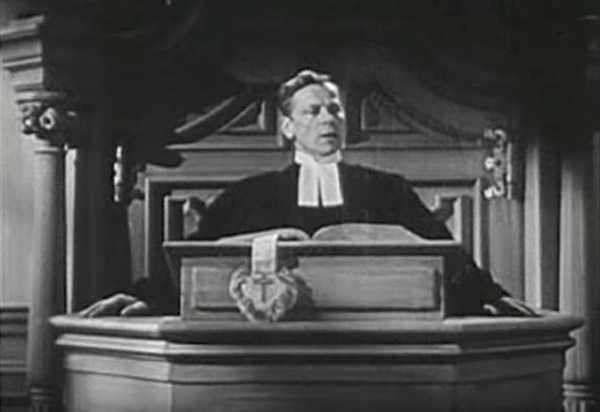
The film has been uploaded to YouTube many times — particularly since 2016 — but following the violent protests in Charlottesville, Don’t Be a Sucker once more made its way around social media.
Many contemporary viewers have pointed out that the film echoes the present. But Don’t Be a Sucker was an object of study in the past. And what the researchers uncovered may be an even grimmer reflection of today’s America, and offer a key takeaway that is good to remember when confronting the resurgence of white nationalist and supremacist rhetoric in the public square.
In the late 1940s, two researchers set out to study the limits of Don’t Be a Sucker
At the film’s more public rerelease in 1947 and 1948, Cooper and Dinerman — working with the Department of Scientific Research of the American Jewish Committee at the Institute of Social Research — explored how viewers’ attitudes were affected by the film, particularly those of high school students. They published their findings in 1951.
Cooper and Dinerman divided a group of high school students into a control group and an experimental group. Only the experimental group saw Don’t Be a Sucker. Four weeks later, both groups were asked to complete a questionnaire, which included some questions related to the message of the film and some control questions. The researchers divided up the answers by factors including the participants’ religious identity (though they only mention Jews, Catholics, and Protestants).

Each group responded strongly to the representation of their particular religious group being isolated and persecuted by Nazis. The film also appeared to have an effect on American-born Protestants who were somewhat prejudiced against Catholics and Jews; after seeing the film, they were about half as likely as the control group to agree with the statement that “in times of depression, it is only right that jobs should be given first to people born in America.”
Still, the numbers seem a bit surprising: After seeing the film, a quarter of the American-born Protestants in the experimental group agreed that people born in America deserved preferential treatment, contrasted with fully half the same segment of the control group.
Don’t Be a Sucker desensitized some viewers to the threat of fascism in America
But the researchers also found a “boomerang” effect in their subjects, which they define as the film having the opposite of its intended effect. They identify four specific “boomerang effects” that Don’t Be a Sucker had on the viewers in their study, but the most interesting for our time is this: Cooper and Dinerman discovered that students who viewed the film were more likely to agree with the statement that “what happened in Germany under the Nazis could never happen in America.”
This is actually the direct opposite of the film’s intended message. The researchers attribute it to the fact that while Don’t Be a Sucker takes pains to show the extent of the Nazis’ cruelty, it only shows one parallel to 1947 America: a man on a soapbox in a square, ranting about foreigners and “negroes” to a skeptical crowd. Many respondents saw the American as simply different from his German counterpart — though the American was giving a similar speech, only the German commanded the respect of a crowd.
One man seems half-convinced by the argument — Mike — but the subjects of the study found him weak, gullible, and passive. Mike only balks when the soapbox speaker rails against Masons (Mike himself is one), but he is quickly talked down by the Hungarian refugee.
The implication, to many of the viewers, was that American fascists are ineffectual and silly, quite different from their German counterparts, no matter how similar their ideology might be.
Don’t Be a Sucker made some viewers more complacent
Cooper and Dinerman also found that the students saw the man on the soapbox as a “lamebrain,” someone whom smart Americans knew to be a fraud and not worth their time.
“Believing that Americans in general would not be taken in by such talk,” they write, “these respondents regarded Americans who do applaud the agitator as uneducated, low-class, or in some other way inferior to themselves.”
They tested this statement with their questionnaire by including the statement: “In America, hardly anyone would listen to a man trying to spread race hate.” And to their surprise, they noticed a definite boomerang effect toward complacency among the students who were less prejudiced against people who were different from them: 29 percent of the students who had seen the film agreed with this statement, compared to 19 percent of those in the control group, who had not seen Don’t Be a Sucker, a result that Cooper and Dinerman called “quite startling.”
Furthermore, they found that 44 percent of those who’d seen the film agreed with the statement, “There are so many minorities in this country that no single one would ever be persecuted” — a sentiment that directly contradicts the film. Only 26 percent of those who hadn’t seen the film agreed with this statement.
“The inescapable conclusion is that the messages about Germany in this film, even when wholly understood, were not applied to America. A plausible hypothesis is that not only the German theme but its link with problems of discrimination seems to be ‘old hat’ to members of the audience,” Cooper and Dinerman wrote.
In other words, the link between fascist, racist sentiments in Nazi Germany and similar ideas as they surfaced in America (even just a few years after the fall of the Third Reich and the end of World War II) were too worn and “old hat” to make an impression on the audience. This bears out: Though the film shows a young black boy playing baseball with white boys, in 1947 America was still deeply segregated, with many white people not seeing a link between their attitude about black people and Nazi racism. (The film itself, after introducing the soapbox fascist as “anti-Negro,” focuses on Jews, Protestants, and Catholics, not race.)
And of course, the study participants were high school students, whose lives so far had been dominated by the looming threat of Nazis “over there,” but who as teenagers had naturally been immature in their understanding of the ideas that caused the heinous violence, and who had driven the conflict. They’d become desensitized.
Americans haven’t stopped thinking they’re too good to be taken in by fascist and racist ideas
Cooper and Dinerman’s paper goes on to evaluate the way Don’t Be a Sucker delivers its message, the limitations of its casting and its audience reach, and how future films of that ilk might convey their arguments more effectively. But two of their insights in particular seem striking in the context of today’s resurgence of white nationalist rhetoric: Don’t Be a Sucker’s viewers thought Americans were too smart to be taken in by fascists, and they were reluctant to draw parallels between Nazi rhetoric abroad and racist, anti-immigration rhetoric at home.

You could hear echoes of this during the Charlottesville events in 2017, whether in expressions of shock over events that many people had forecasted, the #ThisIsNotUs hashtag trending on Twitter that insisted the white supremacists who gathered in Charlottesville are not representative of most Americans, or the president’s initial refusal to specifically condemn the white supremacists who marched in his name. Both well-meaning and more pernicious sentiments abounded: that Americans are “better” than this, that the so-called alt-right are poor and ignorant rather than well-off and educated, that the actions of the Confederacy during the Civil War and of neo-Nazis today are anomalies, and the perpetrators should “go home.”
But others took a different view, pointing out that we can’t pretend racially motivated violence and hate isn’t an integral part of American history.
“The belief that America is somehow better than its white-supremacist history is sometimes an excuse masquerading as encouragement, and it’s part of the reason why the K.K.K. is back in business,” Jia Tolentino wrote at the New Yorker following the rally. “What happened in Charlottesville is less an aberrant travesty in a progressive enclave than it is a reminder of how much evil can be obscured by the appearance of good.”
To be wooed by authoritarian, fascist, divide-and-conquer rhetoric is to be a “sucker.” But thinking we’re too smart to be fooled, that it’s only crazies and lunatics who fall for this stuff — that’s what makes suckers of us all.
Sourse: vox.com






